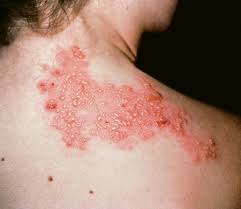Herpes zoster is an acute viral infection of sensory ganglia and the corresponding cutaneous areas of innervation. The disease is characterized by localized pain along the distribution of the nerve and a vesicular skin eruption over a single or adjacent dermatomes. The disease is due to the same virus that causes chickenpox (varicella) and is thought to represent an acute localized recrudescent infection by the varicella virus that has remained latent in the sensory ganglia since the primary attack of chickenpox. Herpes zoster is also called shingles or zona.
Etiology of Herpes Zoster
The varicella or varicella-zoster virus is a herpesvirus. The virus core measures 45 to 50 mg and contains deoxyribonucleic acid. This is surrounded by a capsid with a diameter of 50 to 100 mg and an outer envelope, giving a total diameter of the virion of 150 to 250 mg. The virus is naturally pathogenic only for man, although chickenpox has been seen in anthropoid apes in zoos.
There is some evidence of experimental transmission of the virus to several species of monkeys. The virus can be grown in a variety of cell cultures of human and primate origin but not in nonprimate cells. The virus is avidly cell-associated and can usually be transmitted in the laboratory only by the inoculation of infected cells, although the virus is stable in a cell-free form in the vesicular fluid. Morphologically, varicella virus resembles herpes simplex virus, with which it shares some common antigens, but it is markedly different from herpes simplex virus in its inability to infect nonprimates and nonprimate cell cultures and in its loss of interactivity in most cell-free preparations.
Diagnosis of Herpes Zoster
Characteristic development of pain and vesicular eruptions over single or adjacent dermatomes served by a segmental or cranial nerve branch usually presents no problem in differential diagnosis. However, similar zosteriform lesions can be caused by herpes simplex virus in infants. Diagnosis can be confirmed by the demonstration of multinucleated giant epithelial cells with intranuclear inclusions in Giemsastained scrapings from the base of an early vesicle.
Virions can also readily be found in vesicular fluid by electron microscopic examination. However, neither of these tests differentiates zoster from herpes simplex virus infections, although they can be helpful in differentiating zoster or chickenpox from smallpox infections. Varicella and herpes simplex virus infections can be differentiated by fluorescent antibody staining of cells in scrapings from vesicles. Virus can be isolated from vesicular fluid and, in some cases, from cerebrospinal fluid by inoculation of fluid onto cultures of human or primate cells. Serologic diag- nosis can also be made, but in human sera some cross- reactions are found with herpes simplex virus, so that si- multaneous serologic tests should be carried out against both viruses.
Treatment of Herpes Zoster
Little can be done to treat the acute erup- tion of herpes zoster other than symptomatic application of powder or calamine lotion to the rash and the use of analgesics for the pain. A variety of previously advo- cated treatments such as protamide, vitamins, x irradiation, vasodilators, antimicrobials, and gamma globulin have proved to be useless. In a controlled study cortico- steroids have been shown not to affect the rate of healing or skin lesions but to shorten the period 01′ the acute pain. This benefit must be weighed against the potential haz- ard that corticosteroids may promotedissemination. One study has indicated that 5-iodo-2′.deoxyuridine (IUDR) in dimethylsulfoxide applied topically to the lesions shortens the healing time and the duration of pain, but IUDR without the dimethylsulfoxide is of no value, and dimethylsulfoxide is not available for general use in the United States.
Recently. systemic cytosine arabinoside, a drug inhibitory against DNA virus replication in vitro, has been ad- vocated for the control of severe and disseminated herpes zoster infections. However, in a placebo-controlled study, cytosine arabinoside was found to actually prolong the duration of dissemination in some patients compared to the placebo group. This adverse effect of cytosine arabin- oside appeared to be related to its depression or antibody response, delay in vesicle interferon appearance, and possibly its effect on the cellular immune response. Post herpetic Neuralgia.
The development of pro- longed postherpetic neuralgia after recovery from herpes zoster presents a difficult problem in management. Although this pain usually abates over a period of months to years, it is very refractory to the usual analgesics. Application of cold to the area by use of an ethyl chloride spray may give some transient relief. Tranquilizers or sedatives can sometimes be of help, and tricyclic antide- pressants (amitriptyline) in combination with substituted phenothiazines have been effective in relieving pain in some eases. Local injection or section ofthe nerve root is of no value, and narcotics should be avoided because of the problem of addiction. In the most severe cases when pain persists over long periods, the use of transcutaneous peripheral nerve stimulation or even be considered.
Prevention of Herpes Zoster
No vaccine is available for varicella virus. Chickenpox can be modified if gamma globulin is given after exposure, and sera obtained from patients recuperating from herpes zoster can totally prevent chickenpox in children if given within 72 hours of the time of ex- posure. This zoster immune globulin is recommended for children on immunosuppressive therapy or with leukemia who have been exposed to chickenpox or herpes zoster. Similar measures are not recommended for disabled adults exposed to chickenpox or to zoster, although con- tact should be avoided in the adult patient with a compromised immune system, because it is in this group that occasional cases of zoster have been thought to be related to exposure to chickenpox or zoster.

